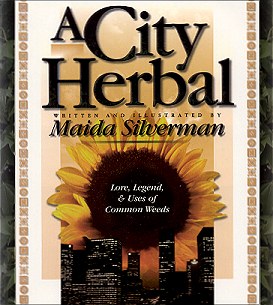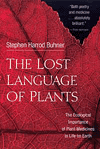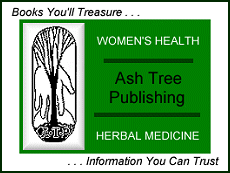The
Lost Language of Plants
The Ecological Importance of Plant Medicines
to Life on Earth by Stephen Harrod Buhner
Chapter Five: The Environmental Impacts
of Technological Medicine
Chapter Seven: “Plants Are All Chemists”
These Excerpts printed courtesy of
Chelsea Green
Publishing Co.
Stephen Harrod Buhner is an award-winning author of seven books on nature, indigenous cultures, the environment, and herbal medicine (including Sacred Plant Medicine).
Chapter Two
The Two Wounds
The exterior and interior wounds that have come from no longer sharing soul essence with the world around us are pervasive, though the interior one is more difficult to see. The exterior wound, however, is easily perceived. . . . By now it has widened, deepened, become so severe that most people routinely acknowledge its existence. This wound is the logging of the rainforest, the pollution and destruction of rivers . . . all the desecration of our exterior world. It has been talked about so much, and we have become so inured, that it is easy to forget that there is a feeling to this exterior wound. A feeling before words, before thinking. A simple, deep response from somewhere inside us recognizing damage to the fabric of life. We can shut these feelings off. But to understand the impact of the exterior and interior wounds it is important to feel them—even if only briefly—even if it hurts.
**********************************************************************
I had been invited to New York to give a talk on . . . the process whereby historical indigenous people developed their knowledge of plant medicines and, to some extent, how, in this present time, we could explore that process for ourselves. . . .
I asked the students if they knew anything about herbalism or plant medicines. None of them did. . . . So I asked them, “Why are you here?”
And they told me the truth. . . .
I turned to the next woman. . . . She looked up shyly, nervously conscious of the women on either side.
“Well,” she said, “lately, I have been thinking of becoming a naturopath. So not too long ago I flew out to Portland to the naturopathic college there to see if it was something I wanted to do.” She paused and moistened her lips, her head tilted slightly down. “Well, there were ten or fifteen of us on a tour and we were stopped in the middle of this hallway. I wasn’t paying attention to what the guide was saying, my mind was wandering, thinking about something else, when out of the corner of my eye I caught a glimpse as she opened a door to my right. I turned and looked and it was the room where they keep all the plants, all the herbs they use for medicine. And I could hear each one of the plants crying out to me, talking as clearly as I am talking to you now. And there were hundreds of them.” She paused for a moment, then went on. “I came today because I thought, that perhaps, something in your talk could help me understand what had happened. I have been thinking, you know,” and here she moistened her lips again and looked nervously around, “that maybe I’m crazy.”
*************************************************************************
Our disconnection from nature and our disavowal of interior depth—of soul—from animals, plants, and landscapes occurs all the time in all of us. But there is more depth in the world than we have come to believe, than we have been taught. Connection with the interior world of nature has been a part of our species’ experience for millennia. Contact with it still occurs when we least expect it: In the glance in a loved one’s eyes, the shadowed green in an old-growth forest, the primal power in the majestic walk of a bear. Or, unexpectedly, in dreams of our grandmothers or our daily interactions with plants. Since the words to describe this kind of depth are atrophied or no longer present in our language, the experience, when it does extrude itself, is often difficult for people to deal with; they sometimes think they are crazy—crazy and alone, the only intelligent life form on Earth.
Chapter Five:
The Environmental Impacts of Technological Medicine
In their drive to conquer disease, the supporters of technological medicine have created a great many industrial products: pharmaceuticals; personal care products (things like sunscreens and antibiotic soaps); radiopharmaceuticals and chemotherapy; and pharmaceutical delivery and medical practice products (things like hypodermic needles, latex gloves, thermometers). All of them end up in the environment. All of them have significant impacts.Pharmaceutical Drugs
The vast majority of pharmaceutical drugs do not heal diseases—they control symptoms by introducing chemical mediators, at specific levels, into the body. People with high blood pressure, for example, are not cured when they take medication, which is why they have to take it regularly, often for the rest of their life.
Unlike plants, blood pressure medications, and nearly all pharmaceuticals, are not a normal part of the diet nor a food previously encountered in our evolution. So, the human body excretes them throughout the day in urine and feces: 50-95 percent of each drug taken is excreted chemically unchanged or unmetabolized.1 As blood pressure medication is excreted blood pressure begins to rise and more of the drug must be taken. Drugs used for acute conditions, such as antibiotics, are usually taken short term; those used for chronic conditions like high blood pressure are usually taken for years or an entire lifetime. In consequence, enormous quantities of pharmaceuticals are going through people’s bodies into the environment, where they are proving to have powerfully negative impacts in ecosystems. And the quantity of drugs and other biologically active medical products that are flowing into the environment is increasing every day.
A recent New York Times article observed that: “Prescription drugs are now the fastest-growing part of the nation’s health care bill. That is not so much because manufacturers are raising prices for existing drugs, but because patients are switching to newly approved medicines that cost more, and more prescriptions are being written than ever before.”2 Retail prescription sales for pharmaceuticals were $42.7 billion in 1991. In 1999, a mere eight years later, sales were $111.3 billion.3 In the next decade, as the knowledge from the unraveling of the human genome makes even more drugs possible, this figure is expected to increase substantially. At present there are some 500 known chemical receptor sites in the human body affected by drugs. With information from the human genome project this number is expected to soar to between 3,000 and 10,000 sites. As Dr. Gillian Woolett of the Pharmaceutical Research and Manufacturers Association excitedly proclaimed, “The rate of change is absolutely incredible.”4 The two scientists who have done the most research on pharmaceuticals in the environment, Christian Daughton (of the U.S. Environmental Protection Agency—EPA) and Thomas Ternes (of the Institute of Water Research and Water Technology in Weisbaden, Germany), comment that “[This] escalating introduction to the marketplace of new pharmaceuticals is adding exponentially to the already large array of chemical classes, each with distinct modes of biochemical action, many of which are poorly understood.”5
Many excreted pharmaceuticals and their metabolites are not biodegradable and go on producing chemical effects forever. Most that do biodegrade are regularly replenished by the need for continual dosing or by new prescriptions for new people. As pharmaceuticals are excreted in pure and metabolized forms they also intermix in the waste streams that flow into the environment in ways that cannot be predicted, with effects that are not understood. Researchers have found that metabolites, chemicals produced as byproducts of pharmaceutical interaction with the body, tend to be more persistent in the environment, and are sometimes more powerful in their actions, than the drugs from which they are derived.6
In 1999 Americans filled 2.8 billion prescriptions covering roughly sixty-six classes of pharmaceuticals. These include: antidepressants, tranquilizers and psychiatric drugs; cancer (chemotherapy) drugs; pain killers; anti-inflammatories; antihypertensives; antiseptics; fungicides; anti-epileptics; bronchodilators; lipid regulators (e.g., high-cholesterol medication); muscle relaxants; oral contraceptives; anorectics (diet medication); synthetic hormones; and antibiotics.7
These pharmaceutical drugs and the personal care products also manufactured by many pharmaceutical companies (such as sunscreen lotions, lipsticks, deodorants, perfumes, and shampoos) are produced in staggeringly huge quantities; often equaling or surpassing agrochemicals in tonnage. The number of pharmaceuticals Americans consume is simply astounding. All of these go into the ecosystem, most of them through excretion into waste treatment systems.
Chapter Five Notes
1. Christian Daughton and Thomas Ternes, “Pharmaceuticals and personal care products in the environment: Agents of subtle change?” Environmental Health Perspectives 107, Supplement 6 (December 1999).
2. Sheryl Gay Stolberg, “A Drug Plan Sounds Great, but Who Gets to Set Prices?” New York Times, July, 9, 2000, section 4, 1.
3. Andrew Sullivan, “Pro pharma,” New York Times Magazine, October 29, 2000, 21; Kathy O’Connell, “Pill Poppin’ Nation,” The Inlander, July 22, 1998; Milt Freudenheim, “Consumers across the Nation Are Facing Sharp Increases in Health Care Costs in 2001,” New York Times, December 10, 2000, section 1, 40; Sonya Ross, Associated Press “Clinton: GOP Drug Plant Is ‘Baloney,’” July 31, 2000—on America On Line (AOL); Eli Ginzberg and Panos Minogiannis, “Medical care in the U.S.—Who is paying for it?” Journal of Practice Management, 15, no. 5 (2000); “Because of the costs many poor Americans and most people in poorer nations are simply out of luck,” Donald McNeil, “Do the Poor Have a Right to Cheap Medicine?” New York Times, June 25, 2000, 18.
4. Peter Montague, “Headlines: Pay Dirt from the Human Genome,” Rachel’s Environment and Health Weekly, #702, July 6, 2000, online at www.rachel.org. (Hereafter Rachel’s).
5. Quoted in ibid.
6. Daughton and Ternes, “Pharmaceuticals and personal care products in the environment.”
7. Rx List: The Internet Drug Index (February 24, 2000), online at www.rxlist.com.
Chapter Seven
“Plants Are All Chemists”
In 1803 Frederich Seturner isolated the first individual plant constituents from opium and named them alkaloids, some 140 million years after complex land plants created them for reasons of their own. Plant chemistry has not been studied very long in the scheme of things; it is still not very well understood.
Consider: Each of the estimated 275,000 different species of plants on Earth contains several hundred to several thousand unique chemicals. The majority of these species manifest as millions of different individuals, all of them generating different variations, sometimes significantly, on their species’ chemical theme. A plant with one thousand different chemical constituents can literally combine them in millions of different ways. To compound the complexity, these combinations, added to those of other plants or of other organisms, produce synergistic results that are not predictable. Even a tiny change in dosage or combination can produce significantly different outcomes. Basically, the little that people currently know about plant chemistry is not very much. This ignorance is magnified by our tendency (because of our upbringing) to think of plants as insentient salads or building materials engaging in chemical production processes that just happened by accident and, in consequence, have no purpose or meaning. Phytoexistentialism.
Still, here we are.
------
The Dance of Plant Chemistry
The carbon atoms that become available from the breakdown of CO2 during photosynthesis form the backbone of all plant chemistry. Plants use this carbon (along with hydrogen, oxygen, and nitrogen) to make their physical structure (whether a huge redwood or a tiny violet growing along a mountain path); primary compounds such as sugar, starch, and chlorophyll; and hundreds of thousands, perhaps millions, of other, complex, secondary compounds: “acids, aldehydes, cyanogenic glycosides, thiocyanates, lactones, coumarins, quinones, flavonoids, tannins, alkaloids, terpenoids, steroids” and more.2 Adding to the complexity, all these compounds can be made using different metabolic pathways—different construction techniques, as it were—and each family of secondary metabolites can contain incredible numbers of substances. Simply altering the relationship between four sugar molecules, for instance, can create over 35,000 different compounds. Over 10,000 alkaloids, 20,000 terpenes, and 8,000 polyphenols are known. About one new alkaloid is identified each day.3
Even though many of these compounds are present only in parts per million or even parts per billion or trillion, they exert significant bioactivity. Their bioactivity can increase substantially, sometimes by several orders of magnitude, when they are combined.4 Through complex feedback loops, plants constantly sense what is happening in the world around them and, in response, vary the numbers, combinations, and amounts of the phytochemicals they make.
--------------
Plant Compounds as Medicines for the Plant Itself
As plants grow, they produce a complex assortment of compounds to maintain and restore health. These include: tannins; antibiotic, antimicrobial, and antifungal compounds; mucilages, gums, and resins; anti-inflammatory compounds; analgesics; and so on. They are stored in different parts of the plant, being released in varying combinations and strengths as needed. Often these compounds are highly reactive when combined or exposed to air and so are kept isolated in holding cells located throughout the plant. The plant can increase the quantity of any of these compounds at the point of need or translocate them extremely rapidly through its tissues.29
Antifungal, antibiotic, or antimicrobial (preinfectious) compounds protect the plant from invading pathogenic organisms. For example: The tulip tree (Liriodendron tulipfera) produces a number of strongly antimicrobial alkaloids (dehydroglaucine and liriodenine) that it stores in its heartwood to protect it from invasion by microorganisms. Chicory (Cichorium intybus) produces a number of strongly antifungal compounds to protect its leaves and roots from pathogenic fungi. The compounds are so potent that even when chicory roots are kept moist on a plate for lengthy periods they will not mold. Other chicory compounds strongly protect against damage or infection from nematodes and other small organisms.30 Plant antimicrobial compounds such as those in chicory are active against microorganisms in exceptionally minute concentrations, ranging from one part per thousand to one part per million.31 During infection other kinds of compounds can be brought into play. Aromatic coumarins in such plants as potatoes increase rapidly at the site in response to any pathogenic organism.32 Cyanogenic compounds are also commonly present in at least a thousand plants where they are released as hydrogen cyanide gas to kill invading organisms.
In many instances invading pathogens release their own compounds that are toxic to the plant. Plants immediately begin to identify these compounds and create chemistries designed to counter them. At the same time, the plant will begin to generate unique compounds—phytoalexins—at the site of infection that are never present in the plant until an infection occurs. When fungal spores take hold on a leaf surface, for instance, and begin inserting growth tubes into the leaf, a plant may begin to synthesize a phytoalexin specific for that fungus. The synthesis begins immediately, can be detected after an hour or two, and reaches its highest concentration in 48 to 72 hours. The phytoalexin is concentrated in leaf cells and pushed out onto the surface of the leaf where the fungus has taken hold.33
-------------
Plants, and their chemistries, do even more, of course. They are intimately interwoven into the lives of all organisms on Earth. And the roles of plants are still more complex. They exist not for themselves alone; they create and maintain the community of life on Earth, they produce the chemistries all life needs to live, and they heal other living organisms that are ill.Chapter Seven Notes
2. Alan Putnam and Chung-shih Tang, “Allelopathy: The State of the Science,” The Science of Allelopathy, ed. Alan Putnam and Chung-shih Tang (N.Y.: John Wiley and Sons, 1986), 4.
3. David Hoffmann, Phytochemistry: Molecular Veriditas, work in progress, 31.
4. Frank Einhellig, “Mechanisms and Modes of Action of Allelochemicals,” and Putnam and Tang, “Allelopathy,” both in The Science of Allelopathy.
29. J. B. Harborne, Introduction to Ecological Biochemistry (London: Academic Press, 1982), see especially chapter 9, 227–259.
30. Hiroyuki Nishimura, et al., “Ecochemicals from Chicory Rhizome,” in Biodiversity and Allelopathy.
31. Harborne, Introduction to Ecological Biochemistry, see 227–259.
32. Ibid, 235.
33. Ibid, 242; Shigeru Tamogami and Osamu Kodamal, “Jasmonic acid elicits momilactone A production: Physiology and chemistry of jasmonic acid in rice phytoalexin production,” in Biodiversity and Allelopathy.
The Ecological Importance of Plant Medicines to Life on Earth
by Stephen Harrod Buhner
Chapter Five: The Environmental Impacts of Technological Medicine
These Excerpts printed courtesy of
Chelsea Green Publishing Co.
This page is sponsored by Ash Tree Publishing
Click here for more great women's health excerpts and reviews
A City Herbal by Maida Silverman

Excerpt: Yarrow (Achillea millefolium)
YARROW SKIN WASH: Yarrow makes an excellent skin wash, its astringency making it particularly beneficial to oily complexions. Pour 2 cups of boiling water over about 1 cup of crumbled dried flowering Yarrow tops, cool, and strain. Pat on the skin. This wash soothes chapping and minor irritations as well. To dry Yarrow flowers: Gather freshly opened flowering stalks, breaking them off at the base. Tie in bunches of three or four and hang upside down to dry, in an airy place, away from direct sunlight. When they are thoroughly dry, remove the flower clusters carefully and discard the rest of the plant. Store the flower clusters in jars with tight-fitting tops, away from the sun. Click here to read more about Yarrow.
Note: close this window to go back to where you came from.




